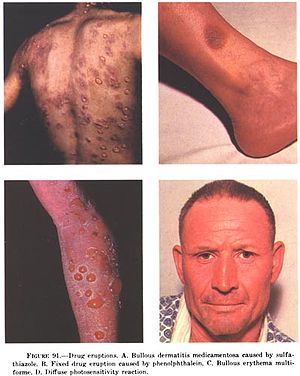Drug eruption
| Drug eruption | |
|---|---|
 |
|
| Examples of drug eruptions. (A) Bullous dermatitis caused by sulfathiazole (B) Fixed drug eruption caused by phenolphtalein (C) Bullous erythema multiforme (D) Diffuse photosensitivity reaction. | |
| Classification and external resources | |
| Specialty | dermatology |
| ICD-10 | L27.0, L27.1 |
| ICD-9-CM | 692.3, 782.1 |
| eMedicine | derm/104 |
| MeSH | D003875 |
In medicine, a drug eruption is an adverse drug reaction of the skin. Most drug-induced cutaneous reactions are mild and disappear when the offending drug is withdrawn. These are called "simple" drug eruptions. However, more serious drug eruptions may be associated with organ injury such as liver or kidney damage and are categorized as "complex". Drugs can also cause hair and nail changes, affect the mucous membranes, or cause itching without outward skin changes.
The drug eruption can be an expected adverse effect or an unexpected effect (idiosyncratic).
Some of the most severe and life-threatening examples of drug eruptions are erythema multiforme, Stevens–Johnson syndrome, toxic epidermal necrolysis, hypersensitivity vasculitis, DRESS syndrome, erythroderma and exanthematous pustulosis.
The most common type of eruption is a morbilliform (resembling measles) or erythematous rash (approximately 90% of cases). Less commonly, the appearance may also be urticarial, papulosquamous, pustular, purpuric, bullous (with blisters) or lichenoid.Angioedema can also be drug-induced (most notably, by angiotensin converting enzyme inhibitors).
...
Wikipedia
